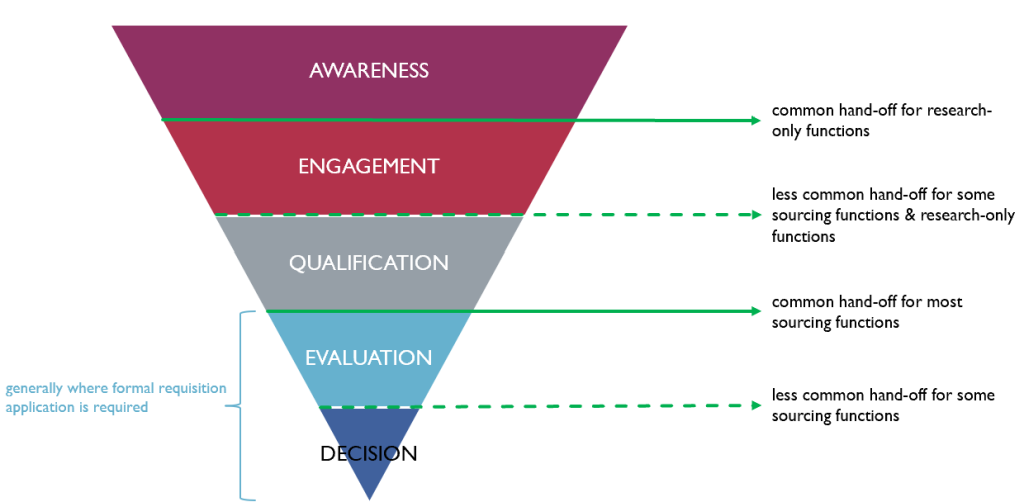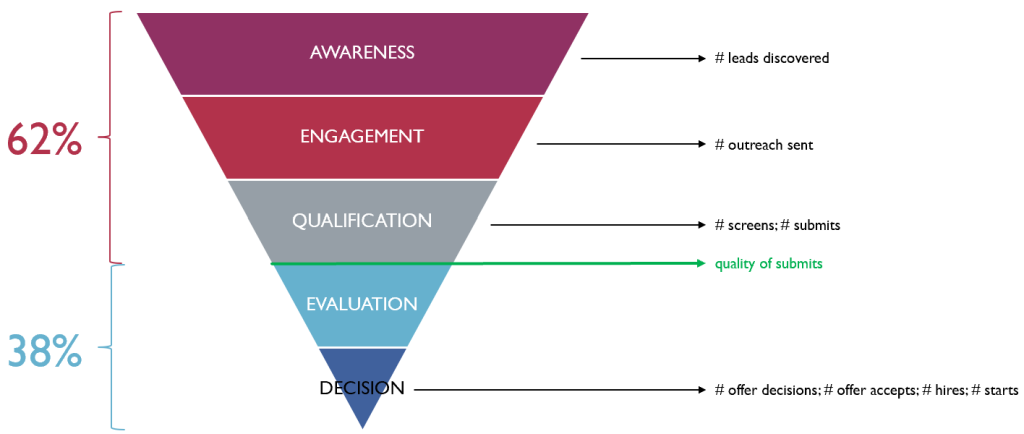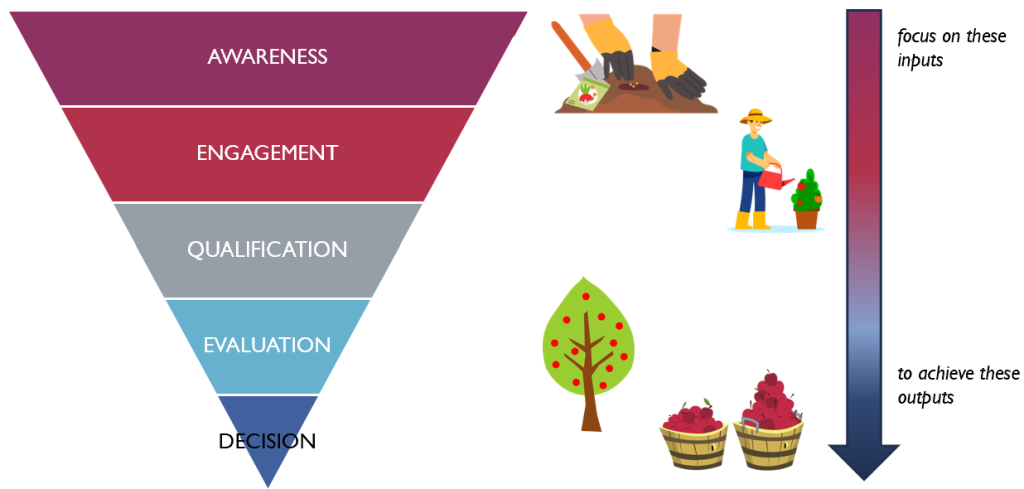At the beginning of my career in talent acquisition, I worked in a recruitment agency as an Internet Researcher. One of the resources my recruiting coworkers had access to was a wonderful tool called “The Lock-On Report™.” This tool assisted them with keeping track of activities and results as well as identifying bottlenecks preventing them from achieving personal and company goals. I thought this was a great tool to help not only with time management but also with maintaining focus on controllable activities that would lead to success in achieving goals. This was the beginning of my interest in TA-related metrics, which over the years has really focused on finding the best places to measure success for talent sourcers.
Having worked as a sourcer myself, I was often measured for success by the same parameters as my recruiting peers – even though I was not involved in many of the activities they were responsible for. I never felt this was fair. I understood having overall team objectives we all worked toward together, but why, when our jobs were so different, should we be measured for success in our individual contributions by the same things? As I transitioned into people leadership, I carried these feelings with me and purposefully looked for more meaningful ways to measure the success of talent sourcers in the teams I managed. Over the years this has become a passion of mine, to ensure talent sourcing as a specialty function would be properly recognized and appreciated for its unique contributions to talent acquisition.
When thinking about how to assign meaningful success metrics and KPI targets for your talent sourcers, you must first have clarity for how talent sourcing is defined for your organization. Once you’ve got that done, the rest can be accomplished through a fairly logical process. The following article covers topics that will help you land on meaningful metrics and KPI targets for your talent sourcers, which includes defining your talent sourcing function, identifying sourcing activities, choosing the right metrics as sourcing KPIs, assigning meaningful KPI targets, and utilizing data to convey impactful stories.
Define Your Talent Sourcing Function First
Before implementing any metrics or KPIs, it is important to define what talent sourcing means within your organization. This involves understanding the specific activities that fall under sourcing and clarifying the mission of your sourcing function. A well-defined talent sourcing function not only sets clear expectations but also minimizes overlap with other roles, particularly recruiters.
Importance of Clarity

The definition of talent sourcing should encompass both actions and outcomes. For instance, it may involve identifying potential candidates, engaging them effectively, and qualifying them for specific roles. Without a clear understanding of these responsibilities, sourcers may end up performing tasks that do not align with their core mission or that overlap too much with recruiters’ duties. As illustrated in the metaphor from Alice in Wonderland, directionless efforts can lead to inefficiency and confusion about roles within a hiring process. How this often manifests is sourcers being tasked with the activities that their partners don’t have time to do or, worse, do not want to do. Simply put, a talent sourcer without clearly defined – and adhered-to – responsibilities is at risk of becoming an extra pair of recruiting hands.
Clarify Responsibilities Using Design Thinking
Knowing this, how you define talent sourcing should be, at minimum, an action that anyone can (and should) do, as well as a way to frame a specialty function’s core responsibilities should you choose to establish a stand-alone function.To successfully accomplish this, you must first initiate discussions with stakeholders—such as leaders, sourcers, and recruiters—to establish a common baseline of current responsibilities and priorities. Once you understand your starting point, from there you can conduct design thinking workshops to help teams work together through visualizing their baselines and identifying overlaps in responsibilities. This will help with pinpointing what activities within a hiring process are viewed as talent sourcing activities, as well as what should/shouldn’t be. Once you align on these, it will be fairly easy to write a clear talent sourcing definition and mission statement for your organization.
Identify Sourcing Activities Within Your Hiring Process and How They Are Currently Measured
Once you have defined your talent sourcing function, the next step is to identify the specific sourcing activities involved in your hiring process and evaluate how these activities are currently measured.
Mapping the Hiring Funnel
The hiring funnel typically consists of several stages: awareness, engagement, qualification, evaluation, and decision-making. Each stage presents unique opportunities for a variety of TA functions to contribute:
- Awareness: Understanding the available internal and external talent pool
- Engagement: Capturing attention through a variety of attraction channels that leverage both active and passive approaches
- Qualification: Assessing whether prospects meet basic requirements for a role, team, or function
- Evaluation: Comparing qualified candidates against one another
- Decision: Making compelling cases for candidates to join
Based on the results from a sourcing metrics survey of 100 TA professionals conducted in August 2024, the majority of participants agreed that sourcing focus is concentrated across Awareness, Engagement, and Qualification-aligned activities such as market research, lead / prospect discovery, conducting initial outreach and engagement, conducting qualifying screens, and in some cases administering specialty skills assessments. This also at times involved focusing on discovering communities and organizations that serve underrepresented talent for purposeful top-of-funnel inclusion.
From here, identifying conversion points between these stages is important for identifying where talent sourcer handoffs should be taking place. Handoffs are critical opportunities to transfer ownership of completed work to a teammate who is responsible for a different part of the process. Ideally, a sourcer’s point of handoff should occur after the last activity where they have control of their work. This visual provides ideas for some typical hand-off points for differently-focused sourcing functions, depending upon where their work is viewed as complete.

Choose the Right Metrics for Sourcing KPIs
Current Sourcing Measurement Practices – Metrics and KPIs
A KPI will always be attached to something that is measured, but not everything that is measured should be a KPI. Metrics are specific aspects of organizational performance, such as operational or tactical activities, whereas KPIs measure progress towards strategic goals and objectives and typically focus on high-level, overall performance. KPIs are critical indicators of success, while metrics are supporting measurements.
The sourcing metrics survey asked those whose organizations currently have sourcing functions what sourcing activities were currently tracked and measured, and also what sourcers were primarily measured on for success. Based on responses from the survey, the highest reported activity that sourcers both focus on and which KPIs are aligned to is submitting quality candidates. A majority of sourcing functions track and report on top-of-funnel activities, yet simultaneously aside from submittal it’s a mixed bag for those activities to be used for sourcing KPIs. Numbers were smaller for those who said they track and report on Evaluation and Decision activities, but interestingly those were shown being used for sourcing KPIs at a higher percentage, and were more represented in teams led by non-sourcing leaders.
Ultimately, what showed up in the results is that while quality of submits is the highest overall primary measure of success, Decision activities are overrepresented when compared to activities that are tracked and measured. This brings us back to the question I asked myself early in my career: why, when our jobs were so different, should we measured for success in our individual contributions by the same things? Should talent sourcers truly be measured for success in their work on offer decisions and hires, when those activities are not generally tracked or reported as part of their regular responsibilities?

Leading vs. Lagging Indicators
A great way to begin understanding how to answer this question is to think about your metrics as leading and lagging indicators.
- Lagging Indicators: These tell you what has already happened. They provide a retrospective view but do not influence future outcomes. These could be considered “fruit on the tree” in terms of metrics and outcomes, such as number of hires, and In TA we do tend to concentrate on reporting these results, outputs, and outcomes.
- Leading Indicators: These are in-process measures and are predictive, therefore they do not guarantee success but they can influence outcomes. These are often tied to sowing and nurturing types of activities and are critical for achieving those desired “fruit on the tree” outcomes.
Balancing both types of indicators allows organizations to understand past performance while also guiding future actions. For instance, measuring submittal quality – how often candidates meet the business’s basic requirements – can serve as a leading indicator that influences downstream results. Both complement one another and are needed to tell a full story. Lagging indicators without leading indicators won’t show how a result will be achieved and provide no early signs about progress towards a strategic goal. As well, leading indicators without lagging indicators may make you feel good about keeping busy with many activities but lack a larger overall purpose.

Recommendations for Sourcing KPIs and Ultimate Success Metrics
I do not believe offer decisions or hires should be used as primary metrics of success for sourcing. These are “fruit on the tree”, lagging indicators of whether top-of-funnel inputs are working. They should be monitored downstream for contribution to business goals, but they should not be the sole or primary method for how we view talent sourcing success. When you start assigning offer decisions or hires as targets or ultimate success measures for talent sourcing, this is when you wind up with competition between recruiters and sourcers. The easiest way to avoid this, in my opinion, is to measure success where a sourcer’s scope of control ends and assign KPIs to activities within that scope.
My current as well as my previous teams have used metrics for KPIs that have included outreach response rates, screens conducted per month, submittals per month, and submittal acceptance. Here are three additional recommendations from some expert resources:
- Association of Talent Acquisition Professionals (ATAP) – this professional non-profit organization released a sourcing metrics whitepaper in 2018 with well-researched and detailed recommendations for sourcing metrics, which include:
- Submittal to Business Accept (%)
- Time to Submit
- Pipeline Conversion(%)
- Sourcing Satisfaction Score
- Join Talent – this UK-based external recruitment consultancy has written a number of excellent whitepapers on a variety of recruitment topics. One of these whitepapers, Building Sourcing Teams, recommends the following sourcing KPIs:
- Reach Out Conversion (%)
- Submittals per timeframe (#)
- Submittals Accepted (%)
- Rob McIntosh – Rob is a well-respected leader in our industry. In an article he wrote, called One Recruiting Metric to Rule Them All, he recommends Submittal to Business Accept (%)
Overall, the constant in all of these recommendations is submittal quality. And the most important metric of these, the one that should indicate overall success of a talent sourcer, is also submittal acceptance quality. This tells us how often we are giving the business what they have asked for and focuses attentions on top-of-funnel activity, which can be controlled by the talent sourcers and informs things further downstream.
Assign Meaningful KPI Targets to the Right Activities
Once you have identified core metrics within your talent sourcing process and what can and should be used for KPIs, it’s essential to assign meaningful targets that will both motivate talent sourcers and contribute to meeting overall team objectives.
Setting KPI Targets
When setting KPI targets, start with the end in mind. The goal is to reverse-engineer from desired hiring outcomes to determine what targets need to be achieved in sourcing activities. This will allow you to tie overall objectives to the activities talent sourcers participate in and have control of, and give you the opportunity to highlight where talent sourcing success is ultimately achieved. A fantastic resource to leverage is Glen Cathey’s Sourcing & Recruiting Candidate Funnel & Output Calculators.
Consider using existing candidate funnel metrics from previous requisitions as benchmarks. If historical data is unavailable, industry standards can serve as a starting point. Additionally, engaging your team in this process fosters ownership over their targets and encourages them to develop data-driven narratives about their performance.
Balancing Qualitative and Quantitative
Quantity and quality in sourcing metrics can be illustrated through understanding precision and accuracy in hitting a bullseye. Being precise means you are able to produce work over and over again and show relatively same results. This is accomplished through repetition and therefore quantitative. Being accurate means you are as close as possible to a true or standard value. This is a measurement of quality. Having one doesn’t guarantee the other; you want a combination of both, which means your measurement system is valid.

Precision lacking accuracy means you are busy, but not likely very successful. Accuracy lacking precision means you find success on occasion but may not be able to reproduce it regularly. You may not be managing your time as well as you could be in order to find repeatable success.
Here are some examples of precision (quantitative) metrics and accuracy (qualitative) metrics.
Precision:
- # leads discovered
- # messages sent
- # screens
- # submittals
Accuracy:
- outreach response rate
- % screen-to-submit
- % submit-to-accept
- % screen-to-offer
- % sourced candidates in overall candidate funnel
- time-to-find
Remember that KPIs are meant to be guides, tools to help you stay on track toward a bigger goal. They should be monitored and calibrated regularly, and should be assigned with consideration to difficulty or location of the role or function, as well as the experience level of the individual. Less experienced sourcers will need more volume to learn what good looks like. Their conversion metrics may not be as good up front but should improve as they talk to more people. For those individuals, their KPIs should focus more on quantity than quality initially and their assignments should be in places where they can pursue higher activity volume to get more practice. More experienced talent sourcers will not need to talk to as many people to find quality – their conversion percentages should be higher and so should their KPI targets. Challenge them to take on more variety to drive higher volume.
Use Data to Share Meaningful Stories
Finally, leveraging data effectively allows you to share meaningful stories about your talent sourcing efforts. This storytelling aspect is vital for communicating successes and areas for improvement within your organization.
Crafting Data-Driven Narratives
Data should not just be numbers; it should tell a story about how talent sourcing efforts contribute to overall business objectives. For example:
- Highlight trends in candidate engagement rates over time
- Showcase improvements in submittal quality leading to higher conversion rates
- Illustrate how targeted outreach campaigns have increased diversity in candidate pools
By presenting data in a narrative format, you can demonstrate the value of your talent sourcing function clearly and compellingly.
Fostering Accountability Through Data
Using data to track progress against KPIs fosters accountability among team members. Regularly reviewing performance metrics allows teams to celebrate successes while also identifying bottlenecks or areas needing improvement. This continuous feedback loop will ensure that everyone stays aligned with organizational goals.
Conclusion
Establishing effective metrics for talent sourcing is an ongoing process that requires careful consideration of definitions, activities, KPIs, and data utilization. By defining your talent sourcing function clearly, identifying relevant sourcing activities and how they are measured, assigning meaningful targets, and using data to tell compelling stories, organizations can optimize their hiring processes and achieve greater success in attracting top talent. Additionally, knowing the work they’re doing is being measured and celebrated with meaningful information, talent sourcers can continue to develop as strategic partners and specialists in their own function and not be resigned to becoming an extra pair of recruiting hands.
